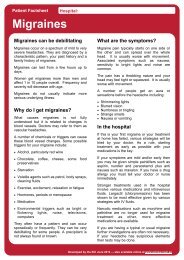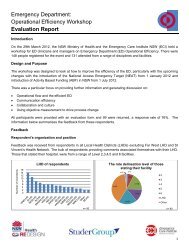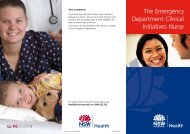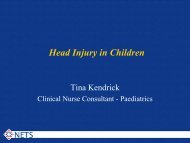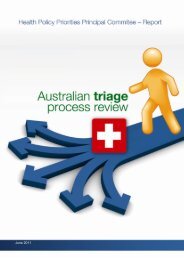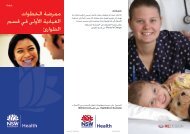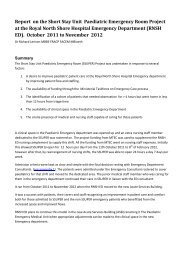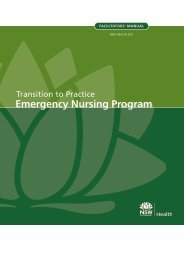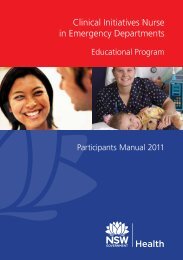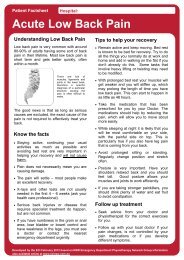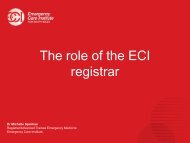Emergency Department Models of Care 2012 - NSW Health
Emergency Department Models of Care 2012 - NSW Health
Emergency Department Models of Care 2012 - NSW Health
- No tags were found...
Create successful ePaper yourself
Turn your PDF publications into a flip-book with our unique Google optimized e-Paper software.
Executive SummarySince the publication in 2006 <strong>of</strong> the ‘<strong>Emergency</strong> <strong>Models</strong> <strong>of</strong><strong>Care</strong>’ document for <strong>NSW</strong> Hospitals, the acceptance andimplementation <strong>of</strong> emergency care models have broadened.This has been coupled with the creation <strong>of</strong> new models toassist <strong>Emergency</strong> <strong>Department</strong>s (ED) to provide safe andtimely access to emergency care. Six years later,PricewaterhouseCoopers has been engaged to, inconsultation with the <strong>NSW</strong> Ministry <strong>of</strong> <strong>Health</strong> (<strong>NSW</strong> <strong>Health</strong>),the <strong>Emergency</strong> <strong>Care</strong> Institute and the community <strong>of</strong> thoseinvolved in <strong>Emergency</strong> <strong>Care</strong>, revise this document.■Complete a self-assessment <strong>of</strong> each relevant MOC toidentify opportunities for improvement within their ownhospitals, as well as to identify key areas that requireongoing monitoring for their effectiveness.After considering the components <strong>of</strong> each model, the EDand hospital should have a clear understanding <strong>of</strong> how themodel works, what data is required to demonstrate a needfor the model, key factors required to implement the modeland measures to assess the model’s effectiveness.In 2011, <strong>NSW</strong> <strong>Health</strong> carried out a review to discover whatcurrent models <strong>of</strong> care (MOC) are in place in EDs and theeffectiveness <strong>of</strong> these models for managing demand fortheir services. The review identified challenges faced by EDsin the operation <strong>of</strong> current models, key principles requiredfor models to operate effectively and monitoring measuresfor ongoing review and quality improvement. The reviewalso aimed to create a standardised suite <strong>of</strong> models <strong>of</strong> careto assist hospitals to provide access to timely, safe andquality emergency care and to meet the National<strong>Emergency</strong> Access Target.Based on this review and our consultations, this revised<strong>Models</strong> <strong>of</strong> <strong>Emergency</strong> <strong>Care</strong> Document (the Document)includes ten <strong>Emergency</strong> <strong>Department</strong> models <strong>of</strong> care and anumber that are external to the ED and support thehospital in managing demand for emergency care. Eachmodel has been designed to facilitate the ideal patientjourney through ED.The Document includes models that are likely to be in placein EDs currently and require revision, as well as those thathave been newly developed in <strong>NSW</strong>. It is intended thatHospital Executives and the ED use the Document to:■■Assess the current <strong>Models</strong> <strong>of</strong> <strong>Care</strong> in their <strong>Emergency</strong><strong>Department</strong>s using the given criteriaAssess the potential to introduce models to theirhospitals that may improve patient care and flow, thepatient experience and clinical outcomesThe Document also describes the benefits and challengesexperienced by EDs who have previously introduced these<strong>Models</strong> <strong>of</strong> <strong>Care</strong>. Reflecting on these lessons, the hospitaland ED can plan accordingly for a model’s implementationin their own location. A ‘case for implementation’ is givenfor each MOC which will enable the ED and hospital toaddress key questions related to the need forimplementation, and hence improve decision-making forplanning and implementation.Created to support this document is a self-assessment toolfor each <strong>Emergency</strong> Model <strong>of</strong> <strong>Care</strong>. The purpose <strong>of</strong> the toolis to allow Local <strong>Health</strong> Districts to assess if a MOC isappropriate for their ED or if an implemented MOC isfunctioning to its utmost potential. The tool is intended tobe used at an ED level in a collaborative approach with allkey stakeholders.The Self-Assessment tool rates the effectiveness <strong>of</strong> eachmodel. Results <strong>of</strong> the self-assessment are then linked toresponses based on the key principles described for eachMOC. A robust evaluation <strong>of</strong> each model can be used togenerate an action plan for an ED to improve thefunctioning <strong>of</strong> current <strong>Models</strong> <strong>of</strong> <strong>Care</strong> being used, or toconsider the implementation <strong>of</strong> new models.It is recognised that not all <strong>of</strong> the <strong>Models</strong> <strong>of</strong> <strong>Emergency</strong><strong>Care</strong> are applicable for all <strong>NSW</strong> <strong>Emergency</strong> <strong>Department</strong>s.Decisions to implement them will be made based on thestaff, patient presentations and space available in the ED tooperate each model.PAGE 2 <strong>NSW</strong> HEALTH <strong>Models</strong> <strong>of</strong> <strong>Emergency</strong> <strong>Care</strong>




